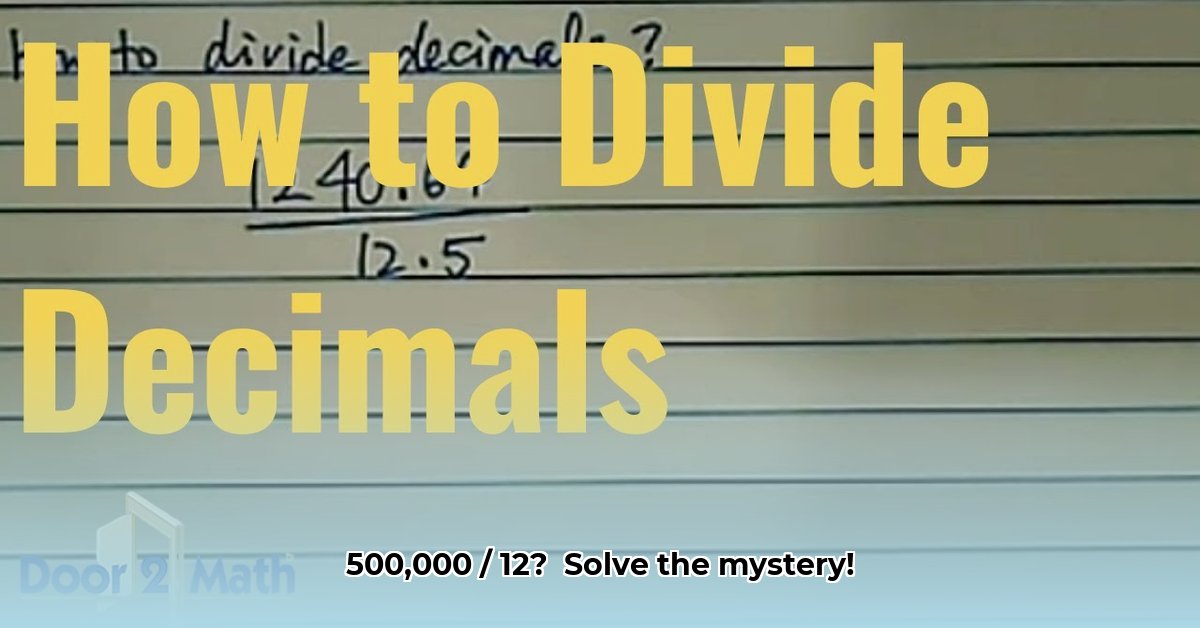
Understanding the Problem: 500,000 ÷ 12
This guide will walk you through different methods for solving 500,000 divided by 12, clarifying the meaning of remainders and decimals in the process. We'll explore long division, calculator methods, and fractional representations, highlighting the strengths of each approach. Understanding this seemingly simple problem unlocks a deeper understanding of fundamental mathematical concepts. Why is this important? Because mastering division isn't just about getting the right answer; it's about understanding the underlying mathematical principles and their applications in diverse real-world scenarios.
Different Paths to the Solution: Long Division, Calculators, and Fractions
Solving 500,000 ÷ 12 can be approached in several ways, each offering unique insights:
Long Division: This classic method provides a step-by-step breakdown, revealing both the quotient (the result of the division) and the remainder (the leftover amount). It's a powerful tool for building a deep understanding of division. It’s like carefully distributing 500,000 items amongst 12 groups – you'll see exactly how many each group receives and what’s left over.
Calculator Method: For a quick result, a simple calculation of 500,000 / 12 provides an immediate answer. However, calculators often express the result as a decimal, which may not be suitable for all situations. For instance, how practical is a decimal result when dealing with a count of physical items, like apples or cars?
Fractional Representation: Expressing the problem as the fraction 500,000/12 allows for simplification and reveals the exact ratio, avoiding the potentially misleading decimal approximation. This approach reveals the essential relationship between the dividend and divisor in its purest form. This is especially helpful in situations where precision is critical.
A Step-by-Step Guide to Long Division
Let's delve into long division for 500,000 ÷ 12:
Setup: Write 500,000 inside the long division symbol (⟌) and 12 outside.
Divide the first digits: 12 doesn't go into 5, so we consider 50. 12 goes into 50 four times (4 x 12 = 48). Write 4 above the 0 in 500,000.
Multiply and Subtract: Multiply 4 by 12 (48) and subtract it from 50 (50 - 48 = 2).
Bring Down: Bring down the next digit (0) to get 20.
Repeat: Continue dividing, multiplying, and subtracting until all digits are used.
Quotient and Remainder: Your final answer will have a quotient (how many times 12 fits into 500,000) and a remainder (what's left over). The quotient is 41,666 and the remainder is 8. This means 12 goes into 500,000 exactly 41,666 times, with 8 left over.
Decimals and Remainders: Understanding the Nuances
The long division approach provides a quotient of 41,666 and a remainder of 8. But what does that mean? The remainder signifies that 8 units remain after equally distributing the 500,000 among 12 groups.
To obtain a decimal answer, continue the long division process by adding decimal points and zeros to the dividend. This allows you to express the remainder as a fraction of the divisor (12), resulting in a repeating decimal of approximately 41,666.666... This repeating decimal accurately reflects the incomplete division. Is a decimal always preferred? No. For example, when dividing up whole items, the remainder is more relevant than the infinite decimal.
Real-World Applications: Beyond the Textbook
Understanding 500,000 ÷ 12 has practical applications in various fields:
Finance: Dividing an annual budget of $500,000 over 12 months helps determine monthly spending limits.
Inventory Management: Distributing 500,000 units to 12 stores requires understanding both the quotient (units per store) and the remainder (extra units needing separate allocation).
Production Planning: Planning production and shipping schedules involves optimizing the division of 500,000 items into batches of 12.
Choosing the Right Method: Context Matters
The best approach – long division, calculator, or fraction – depends entirely on the context. For quick estimations, the calculator suffices. For precise calculations, fractions offer clarity. And when dealing with discrete units, the remainder provides crucial additional information.
“The ability to choose the appropriate mathematical tool is as important as the understanding of the tools themselves,” notes Dr. Evelyn Reed, Professor of Mathematics at the University of California, Berkeley. This emphasizes the importance of understanding the nuances of each method.
This comprehensive guide equips you with the knowledge and skills to solve 500,000 ÷ 12 effectively, regardless of the context or required level of precision. Remember, mathematical understanding is not just about finding answers but also about selecting and interpreting results appropriately.